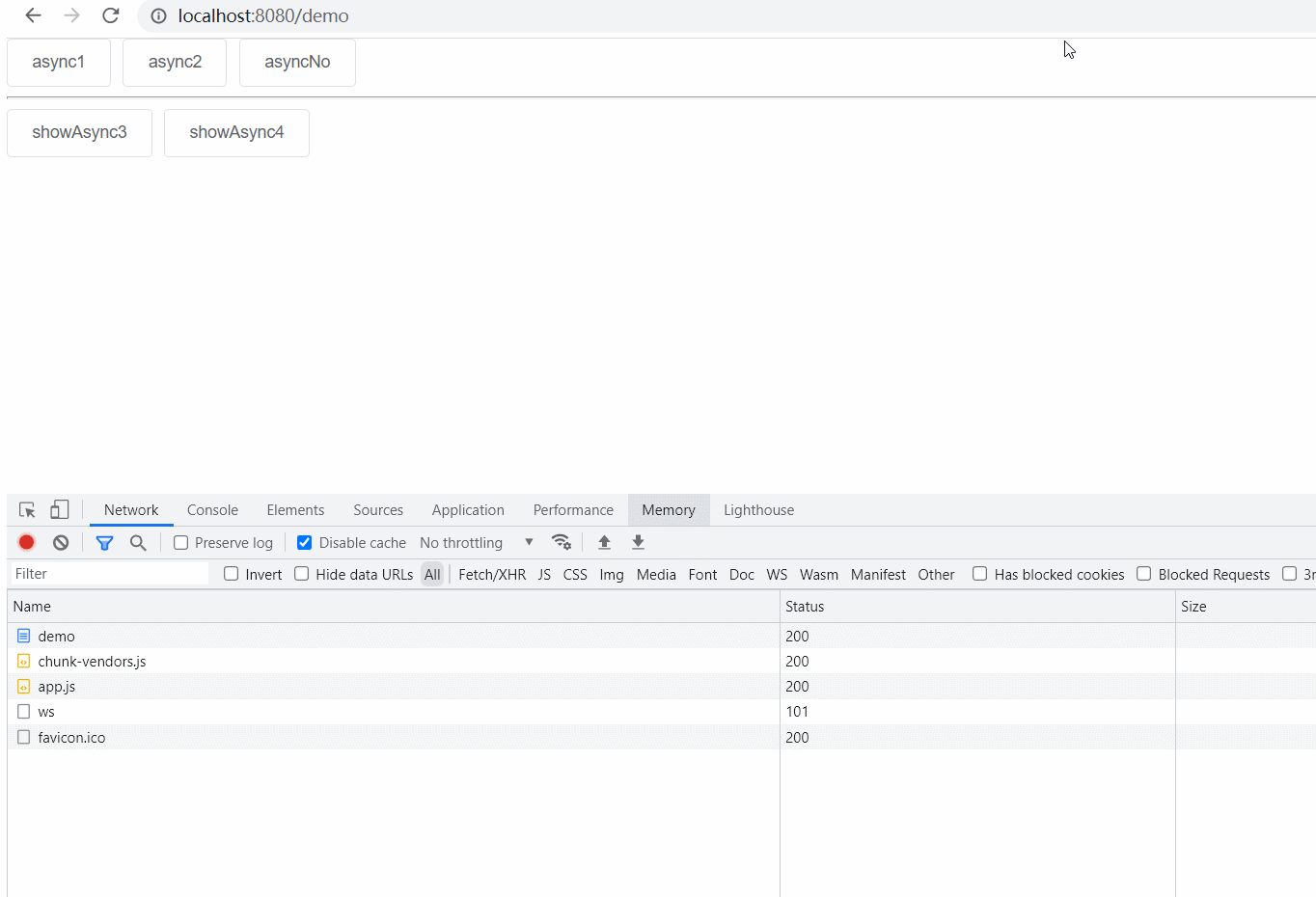vue2异步组件
文章目录
-
- 异步组件
-
- Demo.vue
- Async1.vue
- Async2.vue
- Async3.vue
- AsyncNo.vue
- 异步组件处理加载状态
-
- Demo.vue
- Async4.vue
- Loading.vue
- Error.vue
异步组件
在大型应用中,我们可能需要将应用分割成小一些的代码块,并且只在需要的时候才从服务器加载一个模块。
我们在指定路由所对应的组件,或是,在注册组件时,可以使用异步组件。
Demo.vue
<template>
<div>
<el-button @click="$router.push('/async1')">async1el-button>
<el-button @click="$router.push('/async2')">async2el-button>
<el-button @click="$router.push('/asyncNo')">asyncNoel-button>
<hr/>
<el-button @click="async3Show = !async3Show">showAsync3el-button>
<div v-if="async3Show">
<Async3/>
div>
div>
template>
<script>
export default {
name: 'Demo',
data() {
return {
async3Show: false
}
},
components: {
/* 可以在工厂函数中返回一个 Promise,所以把 webpack 2 和 ES2015 语法加在一起,我们可以这样使用动态导入 */
Async3: () => import(/* webpackChunkName: "async3"*/"@/test/Async3"),
/*这个特殊的 `require` 语法将会告诉 webpack 自动将你的构建代码切割成多个包,这些包会通过 Ajax 请求加载*/
// Async3: resolve => require(['@/test/Async2.vue'], resolve), // 这种方式也可以实现异步组件
}
}
script>
<style>
style>
Async1.vue
<template>
<div>
我是异步组件1
<el-button @click="$router.push('/demo')">/demoel-button>
div>
template>
<script>
/* 异步组件:当第一次切换到当前组件时候,才会去后台请求异步组件渲染函数,请求完了之后,下面这句代码才会执行,然后根据这个渲染函数创建组件实例 */
console.log('异步组件1...');
export default {
name: 'Async1',
components: {
},
created() {
console.log('我是异步组件1 created');
}
}
script>
<style>
style>
Async2.vue
<template>
<div>
我是异步组件2
<el-button @click="$router.push('/demo')">/demoel-button>
div>
template>
<script>
/* 异步组件:当第一次切换到当前组件时候,才会去后台请求异步组件渲染函数,请求完了之后,下面这句代码才会执行,然后根据这个渲染函数创建组件实例 */
console.log('异步组件2...');
export default {
name: 'Async2',
components: {
},
created() {
console.log('我是异步路由组件2 created');
}
}
script>
<style>
style>
Async3.vue
<template>
<div>
我是异步组件3
<el-button @click="$router.push('/demo')">/demoel-button>
div>
template>
<script>
/* 异步组件:当第一次切换到当前组件时候,才会去后台请求异步组件渲染函数,请求完了之后,下面这句代码才会执行,然后根据这个渲染函数创建组件实例 */
console.log('异步组件3...');
export default {
name: 'Async3',
components: {
},
created() {
console.log('我是异步路由组件3 created');
}
}
script>
<style>
style>
AsyncNo.vue
<template>
<div>
我不是异步路由
<el-button @click="$router.push('/demo')">asyncNoel-button>
div>
template>
<script>
/* 这个在没有切换到该组件时, 就已经被router.js中引入执行了,只会执行一次 */
console.log('非异步组件...');
export default {
name: 'AsyncNo',
components: {
},
created() {
console.log('我是非异步路由组件 created');
}
}
script>
<style>
style>
异步组件处理加载状态
Demo.vue
<template>
<div>
<el-button @click="async4Show = !async4Show">showAsync4el-button>
<div v-if="async4Show">
<Async4/>
div>
div>
template>
<script>
import LoadingComponent from './Loading.vue';
import ErrorComponent from './Error.vue';
export default {
name: 'Demo',
data() {
return {
async4Show: false,
}
},
components: {
Async4: ()=>{
return {
// 需要加载的组件 (应该是一个 `Promise` 对象)
component: import('@/test/Async4'),
// 异步组件加载时使用的组件
loading: LoadingComponent,
// 加载失败时使用的组件
error: ErrorComponent,
// 展示加载时组件的延时时间。默认值是 200 (毫秒)
delay: 200,
// 如果提供了超时时间且组件加载也超时了,
// 则使用加载失败时使用的组件。默认值是:`Infinity`
timeout: 500
}
},
}
}
script>
<style>
style>
Async4.vue
<template>
<div>
我是异步组件4
<el-button @click="$router.push('/demo')">/demoel-button>
div>
template>
<script>
/* 异步组件:当第一次切换到当前组件时候,才会去后台请求异步组件渲染函数,请求完了之后,下面这句代码才会执行,然后根据这个渲染函数创建组件实例 */
console.log('异步组件4...');
export default {
name: 'Async4',
components: {
},
created() {
console.log('我是异步路由组件4 created');
}
}
script>
<style>
style>
Loading.vue
<style lang="scss">
body {
margin: 0;
}
.modal {
background: #202020;
height: 100vh;
width: 100vw;
display: flex;
align-items: center;
justify-content: center;
}
.loading {
position: relative;
width: 50px;
height: 50px;
div {
top: 0;
left: 0;
bottom: 0;
right: 0;
margin: auto;
position: absolute;
width: 5px;
height: 20px;
border-radius: 5px;
background-color: #ff7300;
animation: loading-spin 1s infinite;
}
}
@keyframes loading-spin {
0% {
opacity: 0;
}
100% {
opacity: 1;
}
}
.loading .item1 {
transform: rotate(30deg) translate(0,-120%);
animation-delay: 1.1s;
}
.loading .item2 {
transform: rotate(60deg) translate(0,-120%);
animation-delay: 1s;
}
.loading .item3 {
transform: rotate(90deg) translate(0,-120%);
animation-delay: 0.9s;
}
.loading .item4 {
transform: rotate(120deg) translate(0,-120%);
animation-delay: 0.8s;
}
.loading .item5 {
transform: rotate(150deg) translate(0,-120%);
animation-delay: 0.7s;
}
.loading .item6 {
transform: rotate(180deg) translate(0,-120%);
animation-delay: 0.6s;
}
.loading .item7 {
transform: rotate(210deg) translate(0,-120%);
animation-delay: 0.5s;
}
.loading .item8 {
transform: rotate(240deg) translate(0,-120%);
animation-delay: 0.4s;
}
.loading .item9 {
transform: rotate(270deg) translate(0,-120%);
animation-delay: 0.3s;
}
.loading .item10 {
transform: rotate(300deg) translate(0,-120%);
animation-delay: 0.2s;
}
.loading .item11 {
transform: rotate(330deg) translate(0,-120%);
animation-delay: 0.1s;
}
.loading .item12 {
transform: rotate(360deg) translate(0,-120%);
animation-delay: 0s;
}
style>
<template>
<div class="modal">
<div class="loading">
<div class="item1">div>
<div class="item2">div>
<div class="item3">div>
<div class="item4">div>
<div class="item5">div>
<div class="item6">div>
<div class="item7">div>
<div class="item8">div>
<div class="item9">div>
<div class="item10">div>
<div class="item11">div>
<div class="item12">div>
div>
div>
template>
<script>
export default {
name: 'loading',
components: {
}
}
script>
Error.vue
<template>
<div>
加载出错啦
div>
template>
<script>
export default {
name: 'Error',
components: {
}
}
script>
<style>
style>

